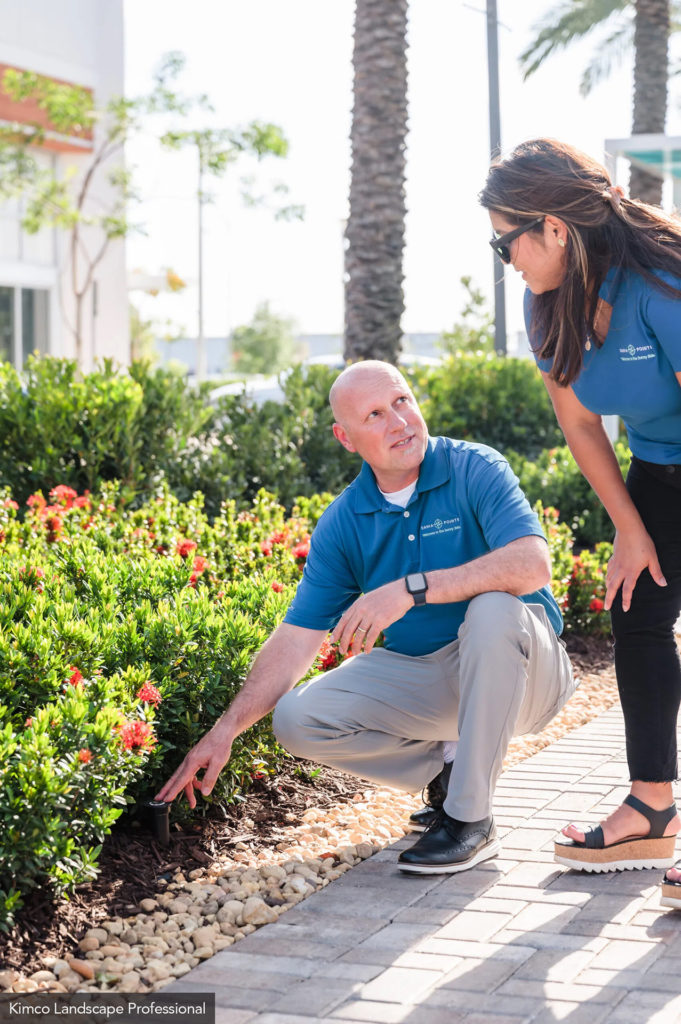Kimco Realty Has Cut Its Water Use by 30% Since 2015 at Project Sites. Here’s How

Kimco is one of the largest publicly traded owners and operators of open-air shopping centers in the United States. About 10 years ago, it launched an initiative to make its properties aesthetically pleasing for its tenants and guests. Better lighting and landscaping were the focus. As such, it began looking into ways it could achieve these enhancements while also being more efficient with its energy and water usage.
“After reviewing our financials, we realized that water usage was a significant expense and rates have been increasing, so we have been seeking ways to better manage these costs,” says Nate Mitten, director of property standards at the firm. “We also learned during the Western drought in 2015 that we needed better tools to manage our compliance with watering restrictions by the various jurisdictions.”
Kimco spends a significant amount on new landscape installments to improve its properties. To protect this investment, it needed an intelligent irrigation system with ongoing monitoring capabilities to identify breaks in the system that might jeopardize the plant’s health.
How much water waste were you wasting?
It depends. During its initial assessment and analysis phase, it discovered that its existing system varied considerably depending on the equipment used, the age of the infrastructure, and the skillset of the landscaper. The goal was to reduce its cost by 30%. To help it achieve those goals, it brought in a vendor called HydroPoint.
The aim was to improve operating costs, minimize business risks, and achieve sustainability goals. The vendor uses a controller attached to a master database that provides data down to a square kilometer. The controller will read how much water a specific plant requires over time. It adjusts that setting based on local weather conditions, type of plant, and soil type — so the database can automatically generate the most effective watering schedule.
Besides providing training, the vendor has a mobile app. That is where a user can easily connect to the water controller while on-site to conduct a test of each zone, looking for any breaks or other issues. An alert is sent if there is a problem.
“ESG (environmental, social, and governance) is a core focus at our company, and water savings is one important aspect of our goals. In fact, we’ve developed a corporate goal of improving common-area water efficiency at properties by 20% by 2025,” says Mitten.
What are the primary challenges?
The main challenge is getting buy-in from some of the local landscape professionals. They can be reluctant to use different technologies. They may also have had a bad experience with new gadgets, and the knee-jerk reaction is to reject them all.
“However, we’ve found that once landscape managers really start using the features of the smart irrigation controllers, they realized that it can be a helpful tool for their work and that it ultimately makes their jobs easier and less time-consuming,” says Mitten.
What are the results and what is the payback?
Since implementing HydroPoint’s WeatherTRAK smart irrigation controllers in 2015, Kimco says that it has reduced its water use by 30% per year on its completed project sites. Before working with the vendor, it aimed to reduce its total water usage by 20% by 2025. Now it is on target to achieve those goals.
The payback calculations can vary widely on the projects but are generally in the 2-4 years range. “While we certainly evaluate the financial metrics of the projects, we take a broader perspective on all the benefits we receive, including the operational efficiencies, protection of our landscaping investments, and advancement of our corporate ESG goals as a responsible member of the communities we serve,” says Mitten.
“While smart irrigation controllers are one great way to reduce water waste, there are other key ways to improve water usage,” adds Mitten. “We’ve found that installing native and drought-resistant plants will also help reduce water usage. For areas that struggle with drought, this is one of the easiest, most cost-efficient ways to save water and establish a more resilient landscape. Similarly, high-efficiency spray heads and drip irrigation systems can be used where possible. These improvements help distribute the water to the plants more efficiently with less loss to evaporation and runoff.”

